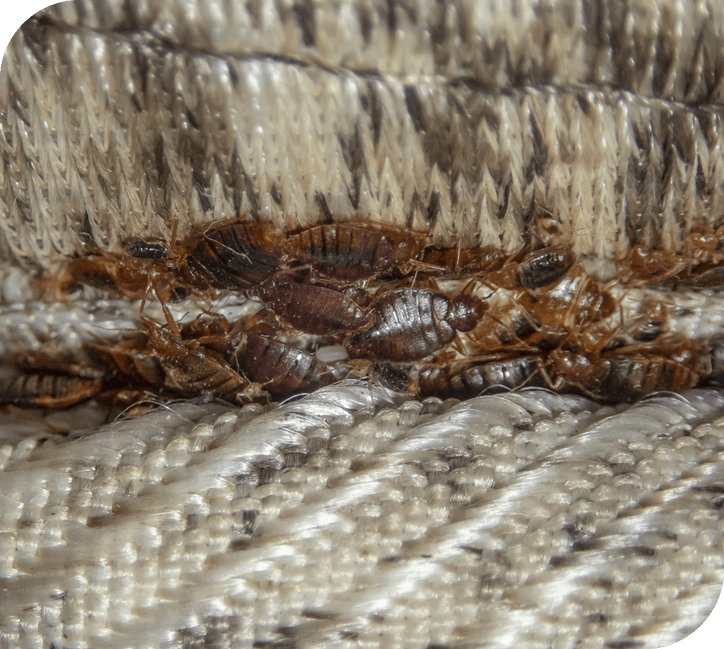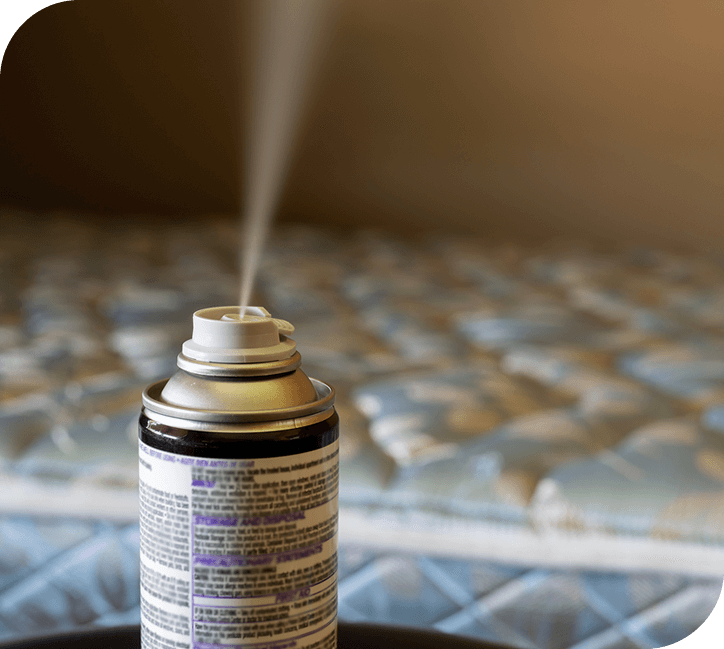We accept Cash, Credit or Zelle

For a bug that is so well entrenched in our language in the United States, for many decades it was a rare occurrence indeed for anyone to actually see a Bedbug. Things have changed. For one reason or another, or perhaps a combination of reasons, we are seeing a distinct resurgence of this blood-sucking parasite throughout the U.S., and the professional pest management industry is now getting frequent calls to eliminate them from homes. Bedbugs are not choosy about who they feed on, and while we still associate them with poorer living conditions it is common for bedbugs to infest upscale homes and happily feed on the sleeping occupants of these residences.
Earlier in the recent history of the United States, perhaps in the first few decades of the 1900’s, bedbugs were so common in our homes that we all knew the little rhyme of “Sleep Tight, Don’t Let the Bedbugs Bite”. Then, perhaps because of the advent of highly effective modern insecticides, bedbugs became almost an endangered species as homes were routinely treated for these and other pests that are capable of causing us problems. For many years it was so unusual for pest control companies to receive calls for bedbugs that new technicians might not even recognize them, and training on how to control them was curtailed for more important teachings. If a pest control company received one call in 10 years for bedbugs they seemed to be about average.

Yes, things have changed. Now, companies may get a dozen calls each month, and the reasons are not entirely understood. Bedbugs continued to be a serious problem in many other parts of the world, even as the United States was enjoying its half century of relief from them, and one conclusion is that worldwide travel, often to more rural and undeveloped circumstances, has allowed us to bring back bedbugs in our luggage. Heavy immigration to the United States might have resulted in great numbers of bedbugs coming along too. Since these critters feed only at night, and hide in daylight, it would be normal to expect many of them to crawl into nearby suitcases after feeding on a sleeping person. Hotels seem to be infested more often than homes, so there could be some credence to this hitchhiker theory.
But, whatever the cause, bedbugs are back. We also need to recognize that there are several different kinds of “bedbugs”, and some of them are more commonly associated with wild animals than with people. Within the group of insects we call bed bugs we find species more likely to be found feeding on various kinds of birds and on bats or rodents. These may be called “bat bugs” or “swallow bugs”, but they gladly feed on humans too if their preferred diet is no longer available. Swallows often create their mud nests under the eaves of buildings, and this is a wonderful means for getting their parasites into the building itself. A study of swallow nests was performed some years ago, and it was found that every single nest inspected had swallow bugs in it.

Even our “common bed bug”, the one that normally feeds on people, will suck the blood from birds and rodents if they are available. In fact, it is believed that the original diet for bedbugs was actually bats, way back before humans existed. As humanity evolved and people moved into caves to live under shelter it is thought that the bat bugs then began feeding on the humans, and over the many centuries we took the bugs with us as we created structures to live in, as we sailed across oceans to new continents, and continued to provide the bugs with the food and harborage they sought.
So, with that little preamble on the history of the bedbugs, the question is “how do we deal with them to get them out of the house?” A quick look at the biology of the bedbug will be of importance. These are nocturnal animals. They don’t like light, and so they hide during hours when the room is lighted and feed only at night. Their hiding places can include virtually ANY tiny crack or opening into which they can squeeze their flattened bodies. This commonly is bedside furniture such as night stands, chairs, or dressers, as well as the bed framing and creases and folds on the mattress. They may hide under lamps, behind pictures on the walls, under the covers for electrical outlets, or even on the ceiling under the plates for ceiling lights and fans. They may crawl into items stored under the bed, or wander into the closet for the multitude of possibilities there.

All of these are locations a professional pest management technician will inspect during his initial visit to your home, and any preparation to facilitate this will help with the control effort. Many of these crevices can be eliminated, such as poorly fitted coving along baseboards or ceiling to wall junctions. Cracks can be filled with putty and painted to hide the repair. However, many others cannot be eliminated, and will likely be treated with a residual insecticide by the licensed professional. They may employ a high-powered vacuum to remove as many of the bedbugs as possible on the initial visit, so that you are immediately relieved of the majority of the parasites. The inspection to determine that you actually have bedbugs will include an examination of the bed covers and mattress for tiny spots of blood. This is the excrement of the bedbug that is eliminated as the bug leaves the site of its feeding. Bedbugs feed for about 5 minutes each session.
The bite is said to be completely without pain or sensation, and bedbugs are not known to be able to spread any diseases to humans. However, a large percentage of people who are bitten can experience mild to serious reactions. Our immune systems don’t like foreign stuff in our pristine bodies, and as bedbugs feed they inject their saliva, and this material can be the trigger, possibly, for anaphylactic reactions that are quite unpleasant.
Because of some scent glands on their body there will often be a distinctive “sweetish” odor in the room where they reside. It’s a tough odor to describe, but you can get the same smell from handling many kinds of beetles as well as other landscape bugs like stink bugs. The bites from bedbugs will occur on any part of the human body, as opposed to flea bites that may be primarily around the lower legs, or mosquito bites on arms or shoulders that are exposed at night.
Even with the excellent tools available to the professional pest management industry, it likely will take several visits to your home to eliminate the bedbugs, once they have become well established. These are tough insects to get rid of. The females can deposit up to 200 eggs over a period of several weeks, gluing them to surfaces within their hiding places. Bedbugs cannot fly, but they crawl very rapidly, and now are being found in rooms away from the bedroom as well. They squeeze into wall voids where it is difficult to place an insecticide, adding to the difficulty in their control. Identification is one of our most important aspects of good pest management, and because there are several species to deal with it may take the trained person to tell the different kinds apart. If it turns out to be a species likely to be related to the presence of bats or birds in the structure, then these sources need to be eliminated as well.

Bedbugs bear a slight resemblance to ticks, and can be distinguished by the presence of only 6 legs as opposed to the 8 legs of ticks. As mature nymphs or as adult bugs they are very round in appearance, flattened from top to bottom, and are a reddish brown color. The adults are about 3/16 of an inch across.
These can be tough guys to avoid completely, especially if you or someone in your family travels a lot to other parts of the world. They could even be acquired by staying in a nice hotel in North America, if a previous guest in that room was nice enough to leave some behind from HIS infested luggage. Poor sanitation is not what bedbugs look for, necessarily, but the cleaner we keep things and the less clutter we have in our homes the less likely bedbugs can get started. We can carefully inspect our own suitcases before we return from a trip overseas, we can thoroughly vacuum our carpets and furnishings, and these activities will help to discover and remove bedbugs.

Most important, though, would be to carefully examine our beds and rooms for the bits of evidence of bedbugs that were discussed earlier – fecal blood spots, bites over our bodies, and the insects themselves behind pictures on the walls or in the folds of the mattress. We might even notice a funny smell in the room that could be associated with bedbugs. You could purchase some small glue pads to place under the bed or under dressers, and possibly capture the bugs as they crawl out from their hiding places. If these are used they must be placed where household pets will not get them stuck onto their fur. If you suspect that birds or bats, or possibly rodents, are using your attic area for their own homes, it would be a very good idea to have them removed by a professional. This can be done without harming the bats or birds, and while we may love these animals we have to recognize the hazards of living too closely with them.
So, be aware, but don’t be paranoid. If you find suspicious bugs in your home you can get them identified by local pest control companies or a local university extension service. If they turn out to be bedbugs you are not in danger of acquiring any weird diseases, but you will want to contact a licensed professional to have them eliminated.